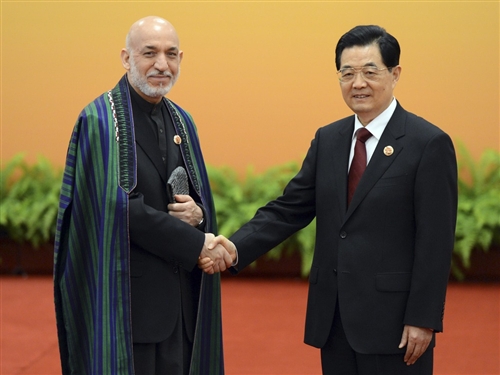
Beijing Proposes Turkmenistan-China Gas Pipeline Through Northern Afghanistan
Publication: Eurasia Daily Monitor Volume: 9 Issue: 116
By:

The Chinese government and Afghan President Hamid Karzai envisage a pipeline to deliver Turkmenistani gas, via Afghanistan’s north and through Tajikistan, to China. This could become a rival or a substitute to the US-backed Turkmenistan-Afghanistan-Pakistan-India (TAPI) pipeline, a decade-old gas transit project. Whether Karzai (let alone Beijing) consulted with Washington on this matter seems far from certain. US officials in Washington appeared surprised in the wake of announcements from Beijing and Kabul about the new proposal which seems to anticipate instability in most of Afghanistan in the years ahead, with the exception of the country’s northern borders.
Karzai met with China National Petroleum Corporation (CNPC) chairman, Jiang Jiemin, and with China’s President Hu Jintao on June 6 and June 8, respectively, during the Shanghai Cooperation Organization’s (SCO) summit in Beijing. The bilateral Chinese-Afghan agenda included the proposed Turkmenistan-northern Afghanistan-Tajikistan-China gas pipeline. CNPC has offered to conduct a technical and economic feasibility study for the proposed pipeline’s sections on the territories of Afghanistan and Tajikistan. Capacity and other basic data have yet to be disclosed. A delegation from CNPC is due in Kabul within the next few weeks, expecting to sign a memorandum of understanding with the Afghan government. The document would cover the proposed transit pipeline, as well as oil and gas exploration by CNPC in Afghanistan’s north. Karzai hailed the pipeline and the exploration project as important to Afghanistan’s stability and development. Returning to Kabul, Karzai ordered his Minister of Mines, Wahidullah Shahrani, to prepare a framework agreement on cooperation with CNPC and to set up a Chinese-Afghan joint working committee on these projects (Xinhua, June 6-9; www.afghan.president.gov, Bakhtiar news agency, June 6; PAN [Pajhwok Afghan News], June 13).
At the same SCO summit in Beijing, CNPC and Turkmennebitgaz signed a framework agreement to increase Turkmenistan’s gas deliveries to China to 65 billion cubic meters (bcm) per year. The time-frame has not been specified publicly. Initial plans (2007-2009) had envisaged deliveries of 30 bcm annually by 2014. Presidents Gurbanguly Berdimuhamedov and Hu Jintao, however, reached a preliminary agreement to roughly double that volume during Berdimuhamedov’s bilateral visit to China in late 2011. The two presidents met again to bless the signed agreement during the SCO summit (TDH [Turkmen Dovlet Habarlary-Turkmen State News Service], Trend, June 8, 10).
With deliveries rising from less than 5 bcm in 2010 to 15.5 bcm in 2011, 24 bcm planned for 2012, and 40 bcm agreed for 2015 (Platts, June 4), Ashgabat and Beijing seem on course toward the ultimate 65 bcm annual target. Growing output from the Bagtyyarlyk gas field and prospective output from sections of the South Yolotan field should supply the additional volumes. CNPC is leading the field development in both areas. The export increase to 65 bcm per year would imply adding 25 bcm to the capacity of the Turkmenistan-China pipeline, which runs via Uzbekistan and Kazakhstan. But it could also imply building another pipeline, on a different route to China.
The proposed Turkmenistan-northern Afghanistan-Tajikistan-China pipeline adds another route, from the same production base to the same destination. Whether this line would carry some or all of the supplementary volume seems too early to tell. Beijing’s initiative with Afghanistan is too fresh even to have been assigned a pipeline acronym. It is, moreover, unclear whether this is a supply project in its own right for China, or (additionally) a maneuver to preempt the US-backed Turkmenistan-Afghanistan-Pakistan-India project (TAPI). TAPI is planned to run through Afghanistan’s Pashtun heartland, where the Taliban is certain to continue operating post-2014. This is a potentially fatal weakness of the project.
Meanwhile, TAPI is designed for an ultimate capacity of 33 bcm of Turkmenistani gas annually. This is planned to be filled partly from the mature Dauletabad field and partly from the prospective Galkynysh fields – of which Yolotan is the largest – yet to be developed. That development seems only possible with the involvement of at least one major international company. Chevron, ExxonMobil and Gazprom are said to be interested in Turkmenistan’s field development, but they are highly unlikely to venture with a pipeline into Taliban-controlled or contested Afghan territory.
For its part, Turkmenistan rules out production-sharing agreements (PSAs) with major international companies onshore. CNPC’s PSA for the Bagtyyarlyk development remains a unique exception thus far. This has not been repeated for South Yolotan’s first phase of development. There, CNPC (along with one UAE-based and two South Korean companies) has only been awarded service contracts; but even this puts CNPC ahead of any competitors for the time being at least (see EDM, October 20, 2011).
Under almost any scenario (see EDM June 19), TAPI and the new, Chinese-proposed pipeline would have to compete over priority access to new Turkmenistani gas volumes, as these come gradually on stream. That new production cannot fully supply both of these pipelines (let alone other pipelines under consideration) simultaneously, but only in a sequence. At least in the short-to-medium term, the lion’s share of new gas production in Turkmenistan will originate in Chinese-led field developments. Moreover, Beijing is in a position to finance its proposed new pipeline (as it did the Turkmenistan-Uzbekistan-Kazakhstan-China pipeline) – a further advantage over TAPI. These two factors can give the new Chinese-proposed pipeline a head start. and make it a winner, even assuming the security situation in the heartland of Afghanistan would not compromise TAPI from the outset.




